What Is Paid Advertising and How Does It Work?
So, you’ve got a great brand, and you want the world to know it. Time to put your money where your mouth is — and nothing speaks quite as loud as paid advertising.

What Is Paid Advertising?
In broad terms, paid ads are pretty much any media space you purchase (as opposed to earned or owned media). Within the realm of digital marketing, paid advertising typically refers to pay-per-click (PPC), pay-per-impression (PPI), or display ads. Here, we’ll explore these types of ads — and more — so you can decide if paid advertising is the right fit to amplify your brand’s voice.
How Does Paid Advertising Work?
So you open your wallet and the clicks and leads start pouring in — easy peasy, right? Not so fast. Paid advertising is a highly effective marketing tool for sure, but it’s a little more complicated than the name lets on.
Most paid ad platforms use a bidding methodology in which you input your max bid per ad and the platform’s algorithm works to place it in open slots. Algorithms vary widely from platform to platform, but most will take into account the amount of your bid and the quality of your ad.
How you currently rank in search — and how the competition ranks — is also an important component of your paid ad strategy. Especially considering that all of these factors will contribute to your cost-per-click (CPC).
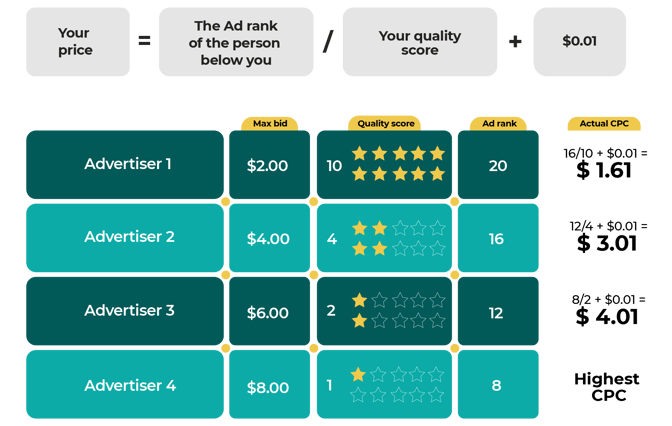
The end goal? Get the most clicks at the lowest CPC to maximize your budget.
Once your ads are placed, there are two ways they can be served up, depending on the ad type. Search ads are triggered when a user enters a specific keyword that matches your ad, while display ads are triggered when a user meets your targeting criteria when browsing other sites.
A Brief History of Paid Advertising
The internet as we know it was still in its youth when online publications began to realize they could earn advertising dollars by selling space on their site, similar to their print versions.
1994: Wired magazine’s online publication begins selling banner ads to advertisers for an upfront cost.
1996: Doubleclick (now under the Google umbrella) starts compiling data based on paid ad performance, allowing advertisers to optimize ads mid-campaign. Cost-per-impression (CPM) became the standard payment method.
1999: GoTo.com creates the first bidding and auction system for paid search ads. It faced backlash as it clogged up SERPs and users began receiving ads not relevant to their search.
2000: Google introduces AdWords, which quickly dominated the market in paid search.
2006: Facebook launches the first social paid ads, using its deep data stores to create exceptionally targeted ads.
And this all brings us to today. Paid ad platforms are more sophisticated than ever, but so are users. Many rely on ad blockers to turn off the noise, and it helps if you understand the dos and don’ts of paid advertising before you try to be heard. To be effective, ads must be highly targeted to buyer personas and aligned with user intent. Low-quality, intrusive ads will do little more than drain your bank account.
Do Paid Ads Work?
You bet they do! At FPS, we’re pretty devoted to organic, inbound, and SEO, but we can’t deny the power of paid. With ad spend projected to top $88 billion this year, it’s a fast-growing, high-dollar industry, and if you want quick, measurable results, it’s a surefire way to get them.
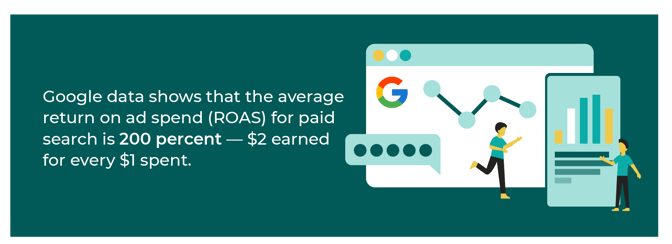
SEO still holds the top spot in our hearts, but the fact is, you can’t guarantee a top spot on Google with organic search. And since the top-ranked result is nearly always an ad placement and receives close to an 8 percent click-through rate, you can’t beat the visibility and results paid ads deliver.
Benefits of Paid Advertising
Not sure the 200 percent ROAS is enough to persuade you? Consider this: Search ads increase brand awareness by 80 percent, and 50 percent of all visitors who find your site via a paid ad are more likely to make a purchase. Need more proof that paid ads will bring value to your brand? We’ve got you covered.
Faster way to drive traffic and revenue
It is a truth universally acknowledged that SEO is a long game. While highly effective at generating long-term, sustainable growth, it isn’t the go-to for making fast bank. Paid advertising, on the other hand, can kick-start your growth quickly and efficiently so you’re still bringing in revenue while you wait for your SEO strategy to take off.
Look at it not as a replacement for SEO but as a powerful complement to it. SEO will get you the results you want tomorrow, but paid ads will help you jump-start your performance today.
Measurable tactics to improve strategy and results
Data-driven marketing is a crucial piece of overall growth marketing. Mining, analyzing, and interpreting data allows you to make informed decisions and pivot quickly when a particular tactic isn’t working.
Paid ads offer twofold benefits in this regard. First, you get real-time insights into how your ads are performing, so you know exactly what moves the needle and when you need to make adjustments. Second, you get access to in-depth information on your audience, which can help you nail down your buyer persona and tailor your other marketing initiatives accordingly.
Reach your audience where they hang out
Paid ads can reach a very broad audience, but they can also target extremely specific niches. Unlike traditional broadcast media (like TV and radio), you aren’t sending out your message in the hopes that the right audience just happens to catch your commercial. Instead, you’re using data, keywords, and custom messaging to hit the right audience when and where it counts.
This may involve some trial and error as you work to understand where your audience is spending time online. You might need to try several social media platforms or tweak keywords for paid search. But once you’ve found them, you’re golden.
Retargeting opportunities
Retargeting or remarketing ads are some of the most effective because they are the most relevant to your audience. Retargeting ads are delivered to users who have already visited your website, whether it’s your homepage or a specific landing page.
Once they’ve shown an interest, you can create customized ads to woo them back, where they’ll be much more likely to convert on follow-up visits. Retarget them across multiple platforms for maximum impact.

4 Paid Advertising Channels to Know
Now you have a good handle on some of the specific terminology around paid ads, and you know when and how they should be used. Time for the big question — where do you use them? That answer will vary based on your audience, your budget, and your goals, but you have plenty of options to test and experiment with.
1. Search Ads
Of course, we all know that Google is the heavy hitter here, with over 92 percent of total search engine market share.
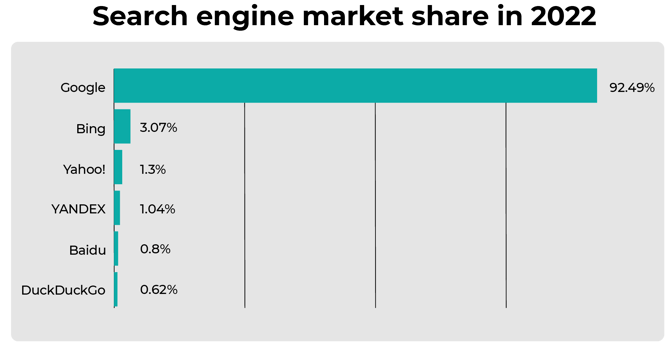
But other search engines also present opportunities to advertise to your target audience.
Google AdsYes, there are other search engines, but no, none of them pack the same punch as Google. No matter what is searched, from pizza and hot yoga to (as in the example below) earrings, your first result — and sometimes your first 3-5 results — will be ads.
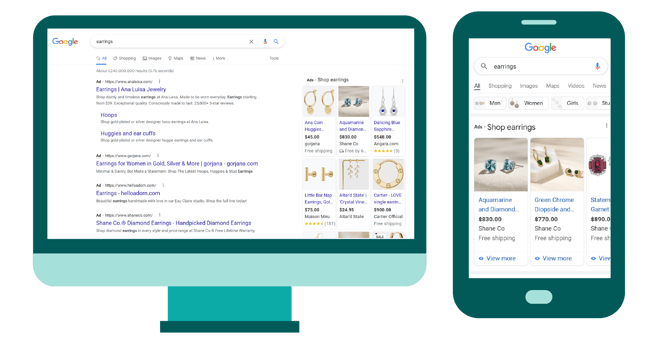
You can see in the example, Google ads are always marked clearly with the bold “Ad” notation. Ads may pop up in a carousel or in a sidebar.
Bing AdsBing is a very distant second in the search engine game, but it still does a lot of business in paid search. Much like Google, Bing ads appear in the top position(s) and sometimes in a sidebar. While Google ads are marked on the left, Bing’s ad designation appears on the right.
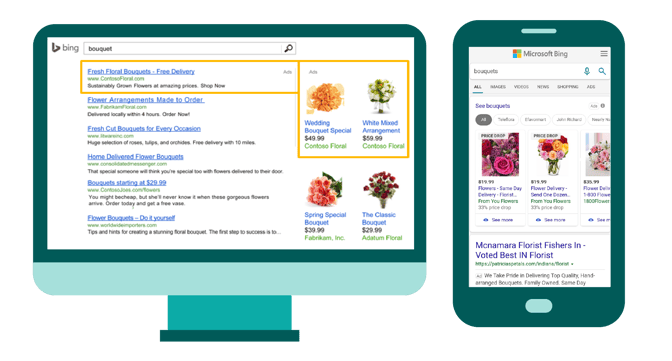
2. Social Media Ads
As we mentioned previously, one of the keys to paid advertising is hanging out where your audience is. There’s no better place to do that than finding a comfy spot in the place they’re sure to spend a lot of their time — social media.
Revenue has grown tremendously over the last few years for social media ads on both desktop and mobile platforms.
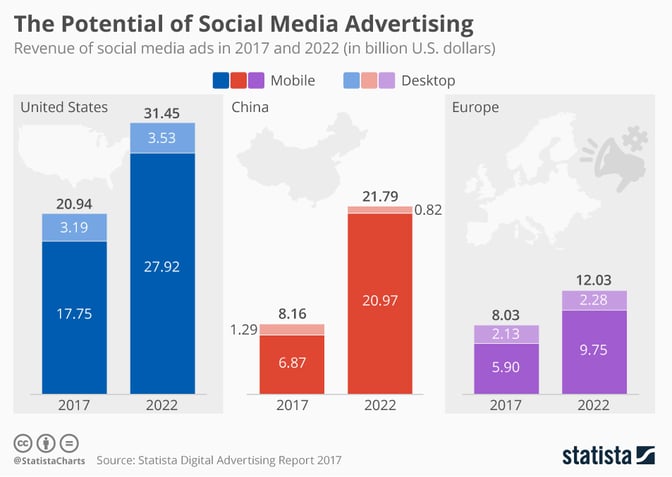
To choose the best social platform, you’ll need to have an in-depth understanding of your buyer persona, and you’ll need to make sure your brand is ready to create interactive, highly sharable content, and engage with followers.
Facebook AdsFacebook ads are incredibly robust and allow deep targeting for almost any audience. It also allows for a wide variety of formats, from static images and video ads to the ad carousels as seen below.

LinkedIn Ads
In general, LinkedIn is a great place to go if you’re targeting professionals within a specific industry. LinkedIn is especially valuable for B2B and SaaS brands who truly understand their niche and what their audience wants and needs.
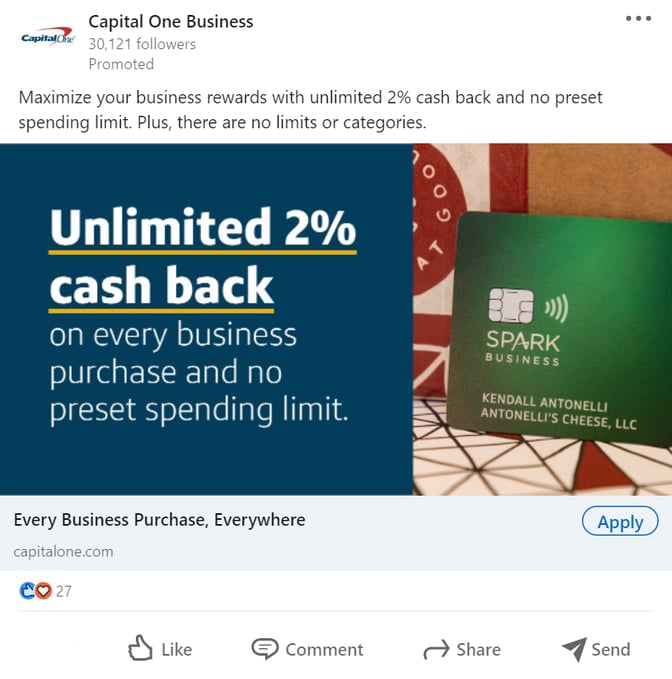
Instagram Ads
Another Meta product, Instagram allows you to manage ads alongside Facebook ads so you can keep your content consistent across platforms. Alternately, Meta also allows you to run them separately if you want to tweak the design or test messaging for different audiences.

Twitter Ads
Twitter ads are a fantastic way to gain new followers. Why does that matter? Because 93 percent of users who follow brands on Twitter say they plan to purchase from them.
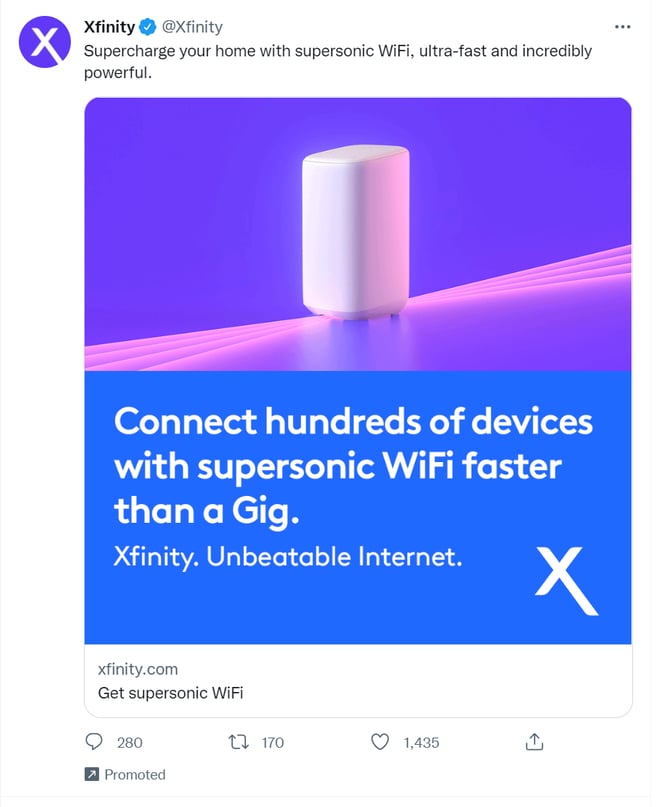
3. Display Advertising
Display advertising is one of the oldest forms of digital paid advertising, and it’s persisted this long because it works. And when it comes to display ads, bigger is usually better. Large banner ads are typically the most effective, as are square ads in the top half of the screen. Smaller, lower positioned ads still perform but not as well.
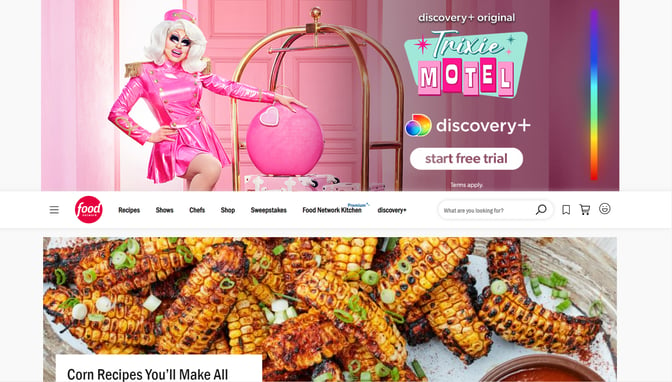
A type of display ad, native ads are generally less intrusive and follow the user experience on a particular website. They match the branding and layout of the site, and often don’t stand out as paid advertising at all.
4. Influencer Marketing
Influencer marketing is booming, with 80 percent of marketers saying it’s an effective ad strategy and nearly 90 percent saying it offers the same or better ROI than other marketing channels.
When searching for influencers, it’s important to know exactly what you want and — more importantly — what you can afford. Celebrity influencers command the big bucks and drive serious revenue, but they don’t come cheap. For many brands, it’s more cost-efficient to look for micro influencers — those with 10,000 followers or less — in your specific industry.
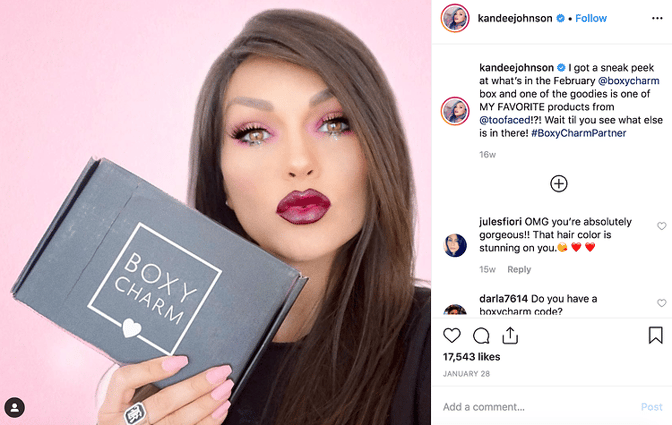
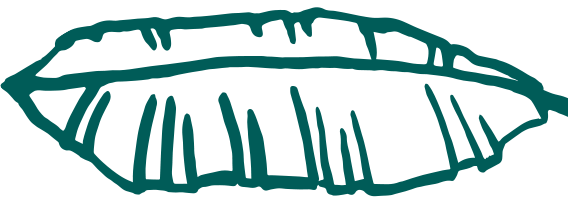
18 Best Practices for Paid Ads
Ready to get started growing your brand with paid ads? But which to choose? In our mind, paid search is a fantastic place to start — it will get you clicks, traffic, and — hopefully — conversions. And you can use keywords to tailor your messaging to reach the right audience. Here’s how to do it:
#1: Identify your ideal audience
You’ve heard us mention buyer persona a time or two and with good reason. You cannot expect your paid search strategy to work if you don’t know who you’re trying to reach. A solid buyer persona will help you determine more than just basic demographics — it will also dig deep into audience attitudes and behaviors and look at psychographic information as well. Before you begin your paid initiative, be sure your buyer persona is airtight.
#2: Determine your goals for paid ads
Looking for more traffic, more followers, or more of the cold, hard cash? Whatever your goals, you need to set them well in advance of launching your paid campaign.
Consider your buyer persona, the buyer’s journey, and where in the funnel your audience will be when they see your ad. Make sure all goals are SMART — Specific, Measurable, Achievable, Relevant, and Timebound.
#3: Understand the buyer’s journey
The buyer’s journey follows your audience throughout their purchase process, from awareness to consideration to decision. The type of ad and the platform you use will depend on which stage of the buyer’s journey you want to reach.
For example, general display ads will be targeted but will still hit a broader audience of those likely in the awareness stage. This is when you want to get your brand top-of-mind. If you’re looking more at retargeting, the users who see your ads are probably somewhere between consideration and decision.
#4: Determine your ad budget
Paid advertising will only take you as far as your budget can stretch. It’s a hard truth, but it’s better to accept it early on — once your money dries up, the results do, too. That’s why it’s important to set your budget early and use it wisely.
You might be tempted to test out lots of platforms, but with the widely used auction system, you either won’t be able to bid high enough to get your ads placed, or your budget will dwindle away before you see any impact.
You’re better off starting with a single platform so you can concentrate your budget to get the best results. Before you get started, use the formula near the start of this article or a free online tool to calculate CPC.
#5: Advertise where your audience hangs out
We’ve said it before and we’ll say it again — you have to know where your audience likes to spend their time before you start placing bids. All of the info you’ve gathered up to this point — buyer persona, buyer’s journey, etc. — will help you determine the right platform to start with.
Spend a little time doing some online sleuthing — check out where your competitors are spending time, what social platforms they’re most active on, and how they interact and engage with the audience there.
#6: Use messaging that works for each audience type
Your buyer persona and your chosen platform will help you create the best messaging for your paid ads. Looking to get leads for your latest SaaS project management tool? You might want to target your message toward early adopters in your industry on LinkedIn.
Want to get conference attendees for a professional convention? Create display ads for placement on online industry publications.
Knowing the audience, understanding their pain points, and having a good handle on where they like to hang online will give you the guidance you need to create high-converting messaging.
#7: Use Long-tail keywords to find quick wins
Long-tail keywords are those that are made up of multiple words or specific phrases. They are typically lower in search volume but much higher in search intent (meaning your audience wants what you’re selling).
When you build your paid search around long-tail keywords, you know that users are looking for exactly what you’re offering. Use an SEO tool to enter your primary head keywords, and find suggestions for long-tail keywords.
#8: Improve ad targeting
This is where having a rock-solid buyer persona will come in very handy. If you know your ideal buyer is generally female and generally between the ages of 25-45, you can set those preferences when targeting your ads. Then, you can layer on other demographic information, like geographic location, specific interests, and behaviors.
#9: Find keywords around pain points
What keeps your buyer persona up at night? What is the problem they wish they could solve but need help in finding a solution? Once you know this, you can tailor your keywords around these specific pain points. Consider their search intent, and answer their most burning questions.
#10: Use sponsored posts to build trust and authority
Sponsored posts (or sponsored ads) are just another way to denote paid advertising. When you put money behind sponsored posts, you’re signaling that you are a trusted voice in your industry.
The top spot on SERPs get the most clicks for a reason. That reason is that we’re conditioned to trust the brands with the biggest name and loudest voice. Snagging these ad spots will help you build brand authority and instill trust in your audience.
#11: Use landing pages to convert traffic
No matter how much you’re willing to shell out on ad bids, if you’re directing traffic to a crummy landing page, you won’t see the results you want. If your paid ads are delivering great numbers in traffic, but very few conversions, take a look at your landing pages because you probably need to optimize them. Make sure they’re customized with messaging that aligns with your ad, and deliver on the ad’s promise.
#12: Write a compelling CTA
Without a call to action, there would be no conversion. Consider the messaging in your ads and what action you want users to take. Make sure that when they arrive at your landing page, that action is clearly outlined, and that every bit of content on there directs them toward taking said action.
For the most part, you want a single CTA per page, though you may want to place it in a couple strategic locations (e.g., one at the bottom of the page, and one “above the fold”).
#13: Build your paid ad strategy
So far, you’ve considered a lot of really critical factors in launching a successful paid ad campaign. But have you put them down on paper? Building a strategy isn’t all that difficult — in fact, you’ve already thought of most of it over the course of this page!
Make sure your strategy includes everything we’ve talked about, like buyer persona, funnel/journey, search intent, SMART goals, budget, and chosen platform. Also be sure that you set a timeline for implementing your strategy so you can be quick to shift tactics if something doesn’t work the way you want.
#14: Ensure campaigns follow best practices
Once you have your strategy in place and you know which platform you’re starting with, it’s time to do some research. Each platform should offer in-depth user guides and best practices for running paid campaigns. Go over them thoroughly and reach out to customer support if you have any questions.
Missing the mark on paid ads can be a costly misstep, so make sure you understand the ins and outs of your chosen platform (like ad sizes, character count limits, etc.) before you get in too deep.
#15: Establish KPIs
Let your goals be your guide when setting up the KPIs you want to measure. If you’re looking for more traffic, that’s an important one to track. But don’t forget other key metrics like CTR, audience engagement, and overall revenue.
#16: Test Ads
But you said not to run multiple ads on multiple platforms at once, right? Right. So what you test instead is your landing page. Create different versions of the page your ad will direct to for A/B testing. This way, you can test out different headlines, CTAs, lead gen forms, and more.
Just remember this crucial detail — only test one change at a time. You don’t want to swap out both your headline and CTA because you won’t know which change affected the results. A/B testing isn’t a one-time deal. You should have an ongoing plan to make small, singular changes for the duration of your ad campaign.
#17: Review results
You know how they say the one thing you should never do when trying to lose weight is weigh yourself every day? The same holds true for paid ad campaigns. Checking results on the daily will only cause stress and misinterpretation of the data.
Yes, you should absolutely be checking regularly, but you want to leave some space in between so you can begin to identify trends. Weekly check-ins work, but in the case of a longer campaign, monthly check-ins will help you see those big picture shifts and learn how your A/B testing is affecting your metrics.
#18: Track and measure
Most platforms you use will give you a built-in way to track your results. It might be a tag or a pixel you need to add to your site, and the platform’s advertising guidelines should give you instructions on how to install them.
You cannot skip this step if you hope to get reliable data from your ad campaign. This is how the platform tracks the users that click through to your site, and the information you can glean from this will help you make adjustments to your buyer persona and your ad strategy so you get even better results the next time around.
Partner with a Paid Ad Specialist to Maximize Your Ad Budget
We know — it’s a lot to take in. But with a little research and planning, you can absolutely create a paid ad campaign that delivers measurable results. A lot of paid ad platforms tout their ease of use and DIY capabilities.
And yes, you certainly can plan, implement, and manage a paid ad campaign on your own. But if you want to maximize your results and make your budget stretch as far as possible, it helps to have support from a trusted expert.
At FPS, we can help you set a budget that will get results and plan a strategy that works. We can also help create visually stunning ads and customized messaging that increase conversion. Want to find out more? Get in touch today!